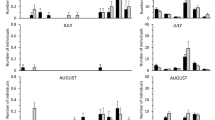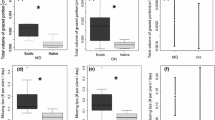Abstract
As the range of the invasive and highly polyphagous gypsy moth (Lymantria dispar) expands, it increasingly overlaps with forest areas that have been subject to invasion by non-native shrubs. We explored the potential for interactions between these co-occurring invasions through a gypsy moth feeding trial using the following three highly invasive, exotic shrubs: honeysuckle (Lonicera maackii), privet (Ligustrum sinense) and burning bush (Euonymus alatus). We compared these with two native shrubs: spicebush (Lindera benzoin) and pawpaw (Asimina triloba). We fed gypsy moth caterpillars foliage exclusively from one of the five shrubs and measured their relative consumptive rate (RCR), relative growth rate (RGR), and development time (DT). The RCR of gypsy moth was strongly influenced by the species of foliage (F = 31.9; P < 0.0001) with little or no consumption of honeysuckle and privet. Caterpillar RGR was influenced by the shrub species (F = 66.2; P < 0.0001), and those caterpillars fed spicebush, honeysuckle or privet lost weight over the course of the assay. Caterpillar DT was also significantly (F = 11.79, P < 0.0001) influenced by the shrub species and those fed honeysuckle, privet and spicebush died prior to molting. Overall, our data suggest that honeysuckle, privet, and spicebush could benefit (indirectly) from the invasion of gypsy moth, while burning bush and pawpaw could be negatively impacted due to direct effects (herbivory). Similarly, invading gypsy moth populations could be sustained on a shrub layer of burning bush and pawpaw in the event of canopy defoliation. Further field and laboratory analysis is needed to clarify herbivore resistance of invasive shrubs, and to investigate the potential interactions among co-occurring insect and plant invasions.



Similar content being viewed by others
References
Anderson JE, Wenwen M, Smith DL, Chang C-J, McLaughlin JL (1992) Biologically active γ-lactones and methyletoalkenese from Lindera benzoin. J Nat Prod 55:71–83. doi:10.1021/np50079a011
Barbosa P, Krischik VA (1987) Influence of alkaloids on feeding preference of eastern deciduous forest trees by the gypsy moth (Lymantria dispar). Am Nat 130:53–69. doi:10.1086/284697
Campbell RW, Sloan RJ (1977) Forest stand response to defoliation by the gypsy moth. For Sci Monogr 19:1–33
Collier MH, Vankat JL, Hughes MR (2002) Diminished plant richness and abundance below Lonicera maackii, an invasive shrub. Am Midl Nat 147:60–71
Davidson CB, Gottschalk KW, Johnson JE (1999) Tree mortality following defoliation by the European gypsy moth (Lymantria dispar L.) in the United States: a review. For Sci 45:74–84
Dorning M, Cipollini D (2006) Leaf and root extracts of the invasive shrub, Lonicera maackii, inhibit seed germination of three herbs with no autotoxic effects. Plant Ecol 184:287–296. doi:10.1007/s11258-005-9073-4
Doskotch RW, Cheng H-Y, Odell TM, Girard L (1980) Nerolidol: and antifeeding sesquiterpene alchohol for gypsy moth larvae from Melaleuca leucadendron. J Chem Ecol 6:845–851. doi:10.1007/BF00990408
Fajvan MA, Wood JM (1996) Stand structure and development after gypsy moth defoliation in the Appalachian Plateau. For Ecol Manage 89:79–83. doi:10.1016/S0378-1127(96)03865-0
Gorchov DL, Trisel DE (2003) Competetive effects of the invasive shrub, Lonicera maackii (Rubr.) Herder (Caprifoliaceae), on the growth and survival of native tree seedlings. Plant Ecol 166:13–24
Gould AMA, Gorchov DL (2000) Effects of the exotic invasive shrub Lonicera maackii on the survival and fecundity of three species of native annuals. Am Midl Nat 144:36–50
Hartman KM, McCarthy BC (2007) A dendro-ecological study of forest overstorey productivity following the invasion of the non-indigenous shrub Lonicera maackii. J Appl Veg Sci 10:13–24
Hintze J (2004) NCSS and PASS. Number Cruncher Statistical Systems. Kaysville, UT
Hutchinson TF, Vankat JL (1998) Landscape structure and spread of the exotic shrub Lonicera maackii (Amur honeysuckle) in southwestern Ohio forests. Am Midl Nat 139:383–390
Jedlicka J, Vandermeer J, Aviles-Vazquez K, Barros O, Perfecto I (2004) Gypsy moth defoliation of oak trees and a positive response of red maple and black cherry: an example of indirect interaction. Am Midl Nat 152:231–236. doi:10.1674/0003-0031(2004)152[0231:GMDOOT]2.0.CO;2
Jermy T (1984) Evolution of insect/host plant relationships. Am Nat 124:609–630. doi:10.1086/284302
Leibhold AM, Gottshalk KW, Muzika R, Montgomery ME, Young R, O’Day K et al (1995) Suitability of North American tree species to the Gypsy Moth: a summary of field and laboratory tests. USDA Forest Service General Technical Report NE-211, Radnor, PA, USA
Lovett GM, Canham CD, Arthur MA, Weathers KC, Fitzhugh RD (2006) Forest ecosystem responses to exotic pests and pathogens in eastern North America. Bioscience 56:395–405. doi:10.1641/0006-3568(2006)056[0395:FERTEP]2.0.CO;2
Luken JO, Thieret JW (1996) Amur honeysuckle, its fall from grace. Bioscience 46:18–24. doi:10.2307/1312651
Luken JO, Kuddes LM, Tholemeier TC, Haller DM (1997) Comparative responses of Lonicera maackii (Amur honeysuckle) and Lindera benzoin (spicebush) to increased light. Am Midl Nat 138:331–343. doi:10.2307/2426826
Mack RN, Simberloff D, Lonsdale WM, Evans H, Clout M, Bazzaz FA (2000) Biotic invasions: causes, epidemiology, global consequences, and control. Ecol Appl 10:689–710. doi:10.1890/1051-0761(2000)010[0689:BICEGC]2.0.CO;2
Mauffette Y, Lechowicz MJ, Jobin L (1983) Host preferences of the gypsy moth, Lymantria dispar, in southern Quebec. Can J For Res 13:53–60. doi:10.1139/x83-008
McEwan RW, Arthur-Paratley LG, Rieske LK, Arthur MA Inhibition of seed germination by Amur honeysuckle (Lonicera maackii). Am Midl Nat (in review)
Miller JH (2003) Nonnative invasive plants of southern forests: a field guide for identification and control. Gen. Tech. Rep. SRS-62. U.S. Department of Agriculture, Forest Service, Southern Research Station, Asheville, NC, 93 pp
Miller JS, Feeny P (1983) Effects of benzylisoquinoline alkaloids on the larvae of polyphagous Lepidoptera. Oecologia 58:332–339. doi:10.1007/BF00385232
Miller KE, Gorchov DL (2004) The invasive shrub, Lonicera maackii, reduces growth and fecundity of perennial forest herbs. Oecologia 139:359–375
Muzika RM, Liebhold AM (1999) Changes in radial increment of host and nonhost tree species with gypsy moth defoliation. Can J Res 29:1365–1373. doi:10.1139/cjfr-29-9-1365
Naidoo R, Lechowicz MJ (2001) Effects of gypsy moth on radial growth of deciduous trees. For Sci 47:338–348
Orr SP, Rudgers JA, Clay K (2005) Invasive plants can inhibit native tree seedlings: testing potential allelopathic mechanisms. Plant Ecol 181:153–165. doi:10.1007/s11258-005-5698-6
Penuelas J, Sardans J, Stefanescu C, Parella T, Filella I (2006) Lonicera implexa leaves bearing naturally laid eggs of the specialist herbivore Euphydryas aurinia have dramatically greater concentrations of iridoid glycosides than other leaves. J Chem Ecol 32:1925–1933. doi:10.1007/s10886-006-9118-8
Rieske LK, Houseman HH, Arthur MA (2002) Effects of prescribed fire on canopy foliar chemistry and suitability for an insect herbivore. For Ecol Manage 160:177–187. doi:10.1016/S0378-1127(01)00444-3
Rieske LK, Rhoades CC, Miller SP (2003) Foliar chemistry and gypsy moth, Lymantria dispar (L.), herbivory on pure American chestnut, Castanea dentata (Fam: Fagaceae), and a disease-resistant hybrid. Environ Entomol 32:359–365
Shields VDC, Broomell BP, Salako JOB (2003) Host selection and acceptability of selected tree species by gypsy moth larvae, Lymantria dispar (L.). Ann Entomol Soc Am 96:920–926. doi:10.1603/0013-8746(2003)096[0920:HSAAOS]2.0.CO;2
Uesato S, Kanomi S, Iida A, Inouye H, Zenk MH (1986) Mechanism for iridane skeleton formation in the biosynthesis of secologanin and indole alkaloids in Lonicera tartarica, Catharanthus roseus and suspension cultures of Rauwolfia serpentinia. Phytochemistry 25:839–842. doi:10.1016/0031-9422(86)80012-7
Acknowledgements
This work was supported by University of Kentucky Faculty Research Support Grant. We thank, Jean-Paul Baptiste, Ryan Quire, Melanie Antonik and Tom Coleman for assistance with data collection. Jim Lempke at the University of Kentucky Arboretum provided access to plant material. This study (# 08-09-080) is connected with a project of the Kentucky Agricultural Experiment Station and is published with the approval of the director.
Author information
Authors and Affiliations
Corresponding author
Rights and permissions
About this article
Cite this article
McEwan, R.W., Rieske, L.K. & Arthur, M.A. Potential interactions between invasive woody shrubs and the gypsy moth (Lymantria dispar), an invasive insect herbivore. Biol Invasions 11, 1053–1058 (2009). https://doi.org/10.1007/s10530-008-9316-0
Received:
Accepted:
Published:
Issue Date:
DOI: https://doi.org/10.1007/s10530-008-9316-0




